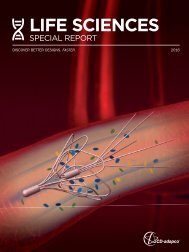Life Science Special Report December 2015
The Life Sciences Sector is experiencing an unprecedented change...
The Life Sciences Sector is experiencing an unprecedented change...
- No tags were found...
You also want an ePaper? Increase the reach of your titles
YUMPU automatically turns print PDFs into web optimized ePapers that Google loves.
DENTAL CEMENT PROJECT LIFE SCIENCES<br />
SOMETHING TO SMILE<br />
ABOUT: USING SIMULATION TO<br />
IMPROVE DENTAL IMPLANTS!<br />
SABINE A. GOODWIN<br />
CD-adapco<br />
KWOK-HUNG (ALBERT) CHUNG & C. WADHWANI<br />
CD-adapco<br />
INTRODUCTION<br />
Cements are commonly used in dentistry,<br />
but there is very little knowledge of<br />
how their fl ow patterns infl uence the<br />
performance of dental systems. One area<br />
in dentistry where shape optimization<br />
should be considered is cementing of<br />
implant restorations. It has been shown<br />
that extrusion of excess cement at the<br />
crown-abutment margin during the seating<br />
of a cement-retained crown over an implant<br />
is a major cause of peri-implant disease<br />
[1-4]. Recent advances in simulation are<br />
now enabling an increased level of insight<br />
into the details of the cement fl ow in these<br />
complex systems, opening the door for<br />
addressing the potential health issues<br />
associated with them and developing<br />
innovative implant designs.<br />
SYSTEMS CONTROL SOLUTION<br />
The cements used in dentistry are non-<br />
Newtonian and shear-thinning in nature<br />
[5]. This means that as more stress is<br />
applied, the cement starts to fl ow more<br />
readily. The stress in the system and<br />
therefore the implant shape is expected to<br />
signifi cantly infl uence the fl ow patterns of<br />
cement including the volume of extrusion<br />
of cement into the surrounding tissue and<br />
the magnitude of extrusion forces. These<br />
parameters have a signifi cant impact on<br />
the surrounding periodontal tissue [3, 4]<br />
and may lead to long term peri-implant<br />
disease, a destructive infl ammatory<br />
condition affecting the gums.<br />
The problem of peri-implant disease as<br />
it relates to cement extrusion must be<br />
addressed from a “systems control”<br />
FIGURE 1: Parameterized model of<br />
implant abutment and crown<br />
solution. Understanding cement fl ow<br />
patterns, appropriate placement sites<br />
and controlling volumes are all critical<br />
for fi nding ways to address the ongoing<br />
health issues associated with cementretained<br />
implant restorations.<br />
Crude models have been used to gain<br />
some understanding of cement fl ow,<br />
including using clear plastic beakers<br />
to visualize the behavior and studying<br />
implant abutments with cast crowns.<br />
Using a “design-build-test” principle in<br />
which the effects of design changes<br />
are quantifi ed by experimental tests on<br />
physical prototypes is often costly and<br />
time-consuming [5, 6]. Simulation, on<br />
the other hand, opens the door for virtual<br />
prototyping and the dental industry is<br />
now beginning to better understand their<br />
complex systems by taking advantage<br />
of the benefi ts numerical simulation has<br />
to offer. This is destined to result in a<br />
paradigm shift within the dental fi eld.<br />
NUMERICAL APPROACH<br />
STAR-CCM+® was used to perform<br />
numerical simulations on the<br />
complete implant abutment, cement<br />
and crown system.<br />
Realistic implant abutment and crown<br />
forms from scanned stereo lithographic<br />
(STL) fi les provided data points for<br />
parameterization of the implant shape<br />
(fi gure 1) and a polyhedral mesh was<br />
developed utilizing the overset meshing<br />
technology available in STAR-CCM+®<br />
to simulate the relative motion of the<br />
crown as it travels over the implant.<br />
The Volume of Fluid (VOF) multiphase<br />
model was used to simulate the fl ow of<br />
cement in the system as it is particularly<br />
well-suited for immiscible fl uids (like<br />
cement and air) and it enables capturing<br />
the position and shape of the interface<br />
between the dental cement and<br />
surrounding air as the crown is seated.<br />
RelyX TM cement (3M ESPE) was chosen<br />
for this study and its non-Newtonian<br />
properties were simulated using<br />
SPECIAL REPORT<br />
27



